[English] 日本語
 Yorodumi
Yorodumi- PDB-7qtu: Structural biology of the NS1 avian influenza protein subversion ... -
+ Open data
Open data
- Basic information
Basic information
| Entry | Database: PDB / ID: 7qtu | ||||||
|---|---|---|---|---|---|---|---|
| Title | Structural biology of the NS1 avian influenza protein subversion on the Scribble cell polarity module | ||||||
 Components Components |
| ||||||
 Keywords Keywords | VIRAL PROTEIN / Influenza A virus / bird-flu / H5N1 / cell polarity / isothermal titration calorimetry / NS1 / PDZ / scribble | ||||||
| Function / homology |  Function and homology information Function and homology informationextrinsic component of postsynaptic density membrane / establishment of T cell polarity / symbiont-mediated suppression of host mRNA processing / cochlear nucleus development / apoptotic process involved in morphogenesis / astrocyte cell migration / myelin sheath abaxonal region / Scrib-APC-beta-catenin complex / establishment of apical/basal cell polarity / polarized epithelial cell differentiation ...extrinsic component of postsynaptic density membrane / establishment of T cell polarity / symbiont-mediated suppression of host mRNA processing / cochlear nucleus development / apoptotic process involved in morphogenesis / astrocyte cell migration / myelin sheath abaxonal region / Scrib-APC-beta-catenin complex / establishment of apical/basal cell polarity / polarized epithelial cell differentiation / synaptic vesicle targeting / epithelial structure maintenance / neurotransmitter receptor transport, endosome to postsynaptic membrane / symbiont-mediated suppression of host PKR/eIFalpha signaling / mammary gland duct morphogenesis / cell-cell contact zone / post-anal tail morphogenesis / establishment or maintenance of epithelial cell apical/basal polarity / activation of GTPase activity / protein localization to adherens junction / auditory receptor cell stereocilium organization / negative regulation of mitotic cell cycle / RND2 GTPase cycle / RND3 GTPase cycle / positive chemotaxis / regulation of postsynaptic neurotransmitter receptor internalization / receptor clustering / negative regulation of activated T cell proliferation / RHOJ GTPase cycle / RHOQ GTPase cycle / positive regulation of receptor recycling / symbiont-mediated suppression of host cytoplasmic pattern recognition receptor signaling pathway via inhibition of RIG-I activity / CDC42 GTPase cycle / immunological synapse / protein serine/threonine kinase inhibitor activity / synaptic vesicle endocytosis / signaling adaptor activity / Asymmetric localization of PCP proteins / neural tube closure / adherens junction / wound healing / cell-cell adhesion / positive regulation of type II interferon production / cell-cell junction / cell junction / cell migration / presynapse / lamellipodium / basolateral plasma membrane / host cell cytoplasm / cell population proliferation / postsynaptic density / positive regulation of apoptotic process / symbiont-mediated suppression of host type I interferon-mediated signaling pathway / cadherin binding / symbiont-mediated suppression of host gene expression / protein kinase binding / host cell nucleus / glutamatergic synapse / RNA binding / extracellular exosome / nucleoplasm / plasma membrane / cytoplasm Similarity search - Function | ||||||
| Biological species |  Homo sapiens (human) Homo sapiens (human) H5N1 subtype (virus) H5N1 subtype (virus) | ||||||
| Method |  X-RAY DIFFRACTION / X-RAY DIFFRACTION /  SYNCHROTRON / SYNCHROTRON /  MOLECULAR REPLACEMENT / Resolution: 2.84 Å MOLECULAR REPLACEMENT / Resolution: 2.84 Å | ||||||
 Authors Authors | Javorsky, A. / Humbert, P.O. / Kvansakul, M. | ||||||
| Funding support | 1items
| ||||||
 Citation Citation |  Journal: Viruses / Year: 2022 Journal: Viruses / Year: 2022Title: Structural Basis of the Avian Influenza NS1 Protein Interactions with the Cell Polarity Regulator Scribble. Authors: Javorsky, A. / Humbert, P.O. / Kvansakul, M. | ||||||
| History |
|
- Structure visualization
Structure visualization
| Structure viewer | Molecule:  Molmil Molmil Jmol/JSmol Jmol/JSmol |
|---|
- Downloads & links
Downloads & links
- Download
Download
| PDBx/mmCIF format |  7qtu.cif.gz 7qtu.cif.gz | 156.9 KB | Display |  PDBx/mmCIF format PDBx/mmCIF format |
|---|---|---|---|---|
| PDB format |  pdb7qtu.ent.gz pdb7qtu.ent.gz | 102.4 KB | Display |  PDB format PDB format |
| PDBx/mmJSON format |  7qtu.json.gz 7qtu.json.gz | Tree view |  PDBx/mmJSON format PDBx/mmJSON format | |
| Others |  Other downloads Other downloads |
-Validation report
| Arichive directory |  https://data.pdbj.org/pub/pdb/validation_reports/qt/7qtu https://data.pdbj.org/pub/pdb/validation_reports/qt/7qtu ftp://data.pdbj.org/pub/pdb/validation_reports/qt/7qtu ftp://data.pdbj.org/pub/pdb/validation_reports/qt/7qtu | HTTPS FTP |
|---|
-Related structure data
| Related structure data |  7qtoC 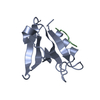 7qtpC 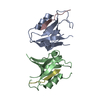 5vwiS S: Starting model for refinement C: citing same article ( |
|---|---|
| Similar structure data | Similarity search - Function & homology  F&H Search F&H Search |
- Links
Links
- Assembly
Assembly
| Deposited unit | 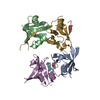
| ||||||||||||
|---|---|---|---|---|---|---|---|---|---|---|---|---|---|
| 1 | 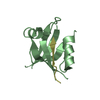
| ||||||||||||
| 2 | 
| ||||||||||||
| 3 | 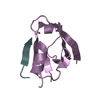
| ||||||||||||
| 4 | 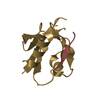
| ||||||||||||
| Unit cell |
|
- Components
Components
| #1: Protein | Mass: 9872.258 Da / Num. of mol.: 4 Source method: isolated from a genetically manipulated source Source: (gene. exp.)  Homo sapiens (human) / Gene: SCRIB, CRIB1, KIAA0147, LAP4, SCRB1, VARTUL / Production host: Homo sapiens (human) / Gene: SCRIB, CRIB1, KIAA0147, LAP4, SCRB1, VARTUL / Production host:  #2: Protein/peptide | Mass: 1165.426 Da / Num. of mol.: 4 / Source method: obtained synthetically / Source: (synth.)  H5N1 subtype (virus) / References: UniProt: Q6B3P2 H5N1 subtype (virus) / References: UniProt: Q6B3P2 |
|---|
-Experimental details
-Experiment
| Experiment | Method:  X-RAY DIFFRACTION / Number of used crystals: 1 X-RAY DIFFRACTION / Number of used crystals: 1 |
|---|
- Sample preparation
Sample preparation
| Crystal | Density Matthews: 2.21 Å3/Da / Density % sol: 44.47 % |
|---|---|
| Crystal grow | Temperature: 293.15 K / Method: vapor diffusion, sitting drop / Details: 0.1M Sodium Cacodylate pH4.2, 40% MPD |
-Data collection
| Diffraction | Mean temperature: 100 K / Serial crystal experiment: N |
|---|---|
| Diffraction source | Source:  SYNCHROTRON / Site: SYNCHROTRON / Site:  Australian Synchrotron Australian Synchrotron  / Beamline: MX2 / Wavelength: 0.95372 Å / Beamline: MX2 / Wavelength: 0.95372 Å |
| Detector | Type: DECTRIS EIGER X 16M / Detector: PIXEL / Date: Oct 18, 2021 |
| Radiation | Protocol: SINGLE WAVELENGTH / Monochromatic (M) / Laue (L): M / Scattering type: x-ray |
| Radiation wavelength | Wavelength: 0.95372 Å / Relative weight: 1 |
| Reflection | Resolution: 2.84→42.94 Å / Num. obs: 8916 / % possible obs: 96.9 % / Redundancy: 3 % / Biso Wilson estimate: 56.7 Å2 / CC1/2: 0.99 / Rmerge(I) obs: 0.069 / Net I/σ(I): 9.6 |
| Reflection shell | Resolution: 2.84→2.99 Å / Rmerge(I) obs: 0.37 / Num. unique obs: 864 / CC1/2: 0.75 |
- Processing
Processing
| Software |
| ||||||||||||||||||||||||||||
|---|---|---|---|---|---|---|---|---|---|---|---|---|---|---|---|---|---|---|---|---|---|---|---|---|---|---|---|---|---|
| Refinement | Method to determine structure:  MOLECULAR REPLACEMENT MOLECULAR REPLACEMENTStarting model: 5VWI Resolution: 2.84→42.94 Å / SU ML: 0.312 / Cross valid method: FREE R-VALUE / σ(F): 1.38 / Phase error: 34.416 Stereochemistry target values: GeoStd + Monomer Library + CDL v1.2
| ||||||||||||||||||||||||||||
| Solvent computation | Shrinkage radii: 0.9 Å / VDW probe radii: 1.11 Å / Solvent model: FLAT BULK SOLVENT MODEL | ||||||||||||||||||||||||||||
| Refinement step | Cycle: LAST / Resolution: 2.84→42.94 Å
| ||||||||||||||||||||||||||||
| Refine LS restraints |
| ||||||||||||||||||||||||||||
| LS refinement shell |
|
 Movie
Movie Controller
Controller


 PDBj
PDBj








